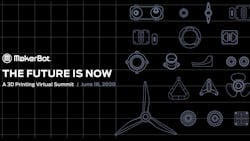On June 18, 3D printer manufacturer MakerBot hosted a virtual summit called “The Future is Now.” Various sessions throughout the day played host to panels and lively discussions between additive manufacturing (AM) designers and engineers on where AM is now and what will help it succeed in the future.
One of these panels, titled “Augmenting Globally Disrupted Supply Chains with 3D Printing, Lessons From a Pandemic,” focused on how the AM community has banded together to help hospitals during the COVID-19 pandemic, and what the industry can take forward in assessing its supply chains. With the dissolved supply chain came the opportunity to assess what went wrong and how to adjust for the future.
JABIL, a manufacturing services company with a facility in Wuhan, China, started seeing implications of the supply disruption early. Rush LaSelle, senior director of digital manufacturing for JABIL, spoke to the company’s attempt to regain some of its 56% drop of products moving through its supply chain.
“It has always—in every case—been a choreographed management and collaborative event to manage a complex supply chain,” LaSelle said. He said the ability of the industry coming to the forefront to combat PPE shortages is showing that the ecosystem is as important as each of the industrial players.
Alex Gil, a digital scholarship librarian for Columbia University, echoed the importance of supply chain considerations. When the university began using its 3D printers to manufacture face shields, he said acquiring the five things it needed to produce the shields was complicated. “It was kind of random which one was going to disappear from our supply chain,” he said. “And our supply chain was organic.”
With the national stockpile being quickly used up during the first few months of the pandemic, the applicability of AM took shape. “I think we very well solidified for corporations one clear place where additive has to play,” said LaSelle. “Production has got to—and will—move closer to consumption,”
He also pointed out three key considerations to help the determine if hospitals and other emergency management entities could buy 3D printers and manufacture goods on their own.
- Safety: Right now, the responsibility of the effectiveness of PPE falls on the OEM.
- Regulatory bodies: Regulators will make it more difficult for the healthcare industry to manufacture its own complicated devices independently.
- Resources: The healthcare industry would not only have to source its own supply chain materials for production, but it would also require the manpower and time.
Nevaris A.C., co-founder and CEO of Tangible Creative, a 3D printing and industrial designer, discussed how the pandemic has shaped the role of his company. “Our goal wasn’t to come in and be the hero,” he said. “Our goal was to help in the moment because we knew we could do it quickly.”
From the manufacturing industry recovery will rise new business models that allow for more specialization, more robust digital manufacturing avenues and more agile processes. LaSelle discussed that certain AM supply chain aspects, such as injection molding, will always have a place, but the industry shouldn’t be overeager to shut down all the CNCs.
“I think it’s important to have the case study to show the beautiful aspects that were able to happen with additive manufacturing,” said A.C. “But not contribute to the fantasy of ‘we just made these out of nothing in our kitchen.’ There are many, many moving parts to make this happen.”
The important thing to remember about supply chain development, Gil said, was to have preparedness scenarios in place that support more nimble efforts for moments of crisis.
“Is a traditional path what we need in order to respond to these kind of things? Are our business models what’s going to help us?” he said. “I’m not saying to get rid of them, but to supplement them for these moments of crisis, whether it be hurricanes or pandemics.”
About the Author
Marie McBurnett
Senior Editor, Machine Design

Leaders relevant to this article:
